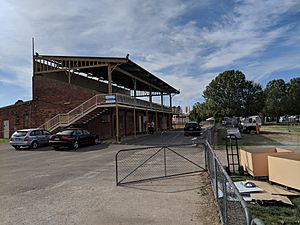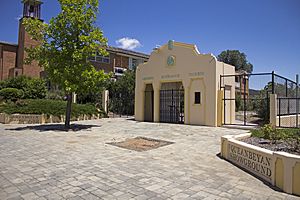Queanbeyan Showground facts for kids
Quick facts for kids Queanbeyan Showground |
|
|---|---|

Grandstand
|
|
| Location | 19-41 Farrer Place, Queanbeyan, Queanbeyan-Palerang Region, New South Wales, Australia |
| Owner | Queanbeyan City Council |
| Official name: Queanbeyan Showground | |
| Type | state heritage (complex / group) |
| Designated | 15 March 2013 |
| Reference no. | 1890 |
| Type | Other - Landscape - Cultural |
| Category | Aboriginal |
| Lua error in Module:Location_map at line 420: attempt to index field 'wikibase' (a nil value). | |
The Queanbeyan Showground is a historic site located at 19-41 Farrer Place in Queanbeyan, New South Wales, Australia. It's owned by the Queanbeyan-Palerang Regional Council. This important place was added to the New South Wales State Heritage Register on March 15, 2013, because of its special history and cultural value.
A Long History
The Queanbeyan Showground has a very long and interesting history. For many, many years, it has been a significant place for people to gather.
Aboriginal History and Gatherings
Before Europeans arrived, the land around Queanbeyan was home to Aboriginal groups like the Kamberri and Ngambri. They used this area, including what is now the showground, as a traditional meeting and burial place.
Records show that Aboriginal people camped here as early as the mid-1800s. They held large gatherings, sometimes called corroborees, which were important cultural events. People from many different tribes, even from far away, would come together. These gatherings were for celebrations, ceremonies, sharing news, trading, and arranging marriages.
One of the last big corroborees in the Queanbeyan area happened at the showground in 1862. Hundreds of Aboriginal people attended this event, which lasted for many weeks. Even today, local Aboriginal people feel a strong connection to this site because of their ancestors' history here.
European Settlement and Showground Beginnings
The town of Queanbeyan started to grow in the 1830s. By 1862, much of the showground area was set aside as a "Recreation Ground" for the community.
In 1883, a part of this recreation ground was officially made into a showground. This is when agricultural shows, which are events to show off farm animals and produce, began to be held here. Over the years, the showground grew bigger.
Popular Events and Activities
The annual Queanbeyan Show quickly became one of the most important events in the town. People would come from all around to enjoy the displays and competitions.
The showground also hosted many other activities. In 1927, a special track was built for harness racing, also known as trotting. This became a very popular sport, and the showground was a major venue for it until 1968.
Other events held here included carnivals, circuses, and even greyhound racing. During World War II, the showground was used by soldiers for training. It has also served as a temporary caravan park during floods.
Important Structures and Features
You'll find some historic structures at the showground. The grandstand, a large building with seating for spectators, was built around 1939. It has a corrugated iron roof and a walkway.
At the Lowe Street entrance, there are memorial gates built in 1934. These gates honor Thomas Collett, a local businessman who helped start the Agricultural Association. There's another similar gateway on Farrer Place.
There are also old, mature trees on the grounds, especially at the western end.
Protecting the Showground
After the 1970s, there was talk about developing the showground for other uses. However, many people in Queanbeyan, including the Show Society and Aboriginal groups, strongly opposed this. They wanted to keep the showground as it was.
This public support helped protect the showground. In recent years, the annual show has become very popular again, showing how much the community values this historic place.
Why the Showground is Special
The Queanbeyan Showground is listed on the New South Wales State Heritage Register because it's very important for several reasons.
Cultural Significance
The showground is extremely important to the Aboriginal community. It was a traditional camping and ceremonial place long before European settlement. These gatherings were vital for their culture and traditions. It's also a known burial site for Aboriginal people.
Historical Importance
This site shows us how people lived and used land in the past. It's a great example of a place that was important to both Aboriginal people and later, the European community. It also shows how agricultural shows became a big part of country life.
Design and Appearance
The grandstand, built around 1939, and the original entrance gates are good examples of the architecture from that time. They add to the historical look and feel of the showground.
Community Connection
The showground has a strong connection with the Queanbeyan community. For many years, it has been a place for social events, agricultural shows, and various recreational activities. It brings people together and is a big part of the town's identity.
Research Potential
The site has the potential to teach us more about history through archaeological finds. Objects and even burials have been found here, which can help us understand more about the past.
Rarity
The Queanbeyan Showground is a rare example of a well-documented Aboriginal ceremonial and camping place that was used both before and after European settlement. The detailed records of the 1862 corroboree give us a unique look into Aboriginal ceremonies from that time.
Example of Cultural Resilience
This showground is an excellent example of how Aboriginal culture continued to thrive and adapt, even as European settlement expanded. It shows the strength and lasting importance of Aboriginal traditions.


